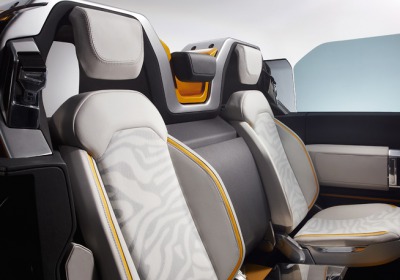Land Rover DC100 Sport (2011) at Frankfurt motor show
Tue, 13 Sep 2011
Land Rover has unveiled a second Defender concept car at the 2011 Frankfurt motor show. We’ve already seen the DC100, and now there’s the DC100 Sport. Land Rover has built them both to gauge public interest and decide in which direction the next Defender – due in 2015 – should be engineered. Read on to find out about the DC100 Sport, and to learn more about the DC100
How does the new Land Rover Defender DC100 Sport differ from the DC100?If we’re simplistic about it, the DC100 is a conventional three-door 4x4, and the new DC100 Sport is a pick-up. According to Land Rover, the DC100 ‘demonstrates the future of Land Rover capability and versatility’ while the DC100 Sport is ‘an active expression of freedom and leisure’.
Both concepts use the same lightweight, mixed-alloy platform with an identical 100-inch wheelbase, plus 2.0-litre four-cylinder engines driving all four wheels through a stop/start-equipped eight-speed automatic. The DC100 has a diesel engine, the DC100 Sport has a petrol engine, and LR says both are capable of being configured as parallel or plug-in hybrids.
The DC100 has an upgraded version of LR’s existing air suspension system, which can push the ride height up to 320mm, while the DC100 Sport uses a third-gen MagneRide adjustable damper set-up for better on-road handling.
Presumably both can still mud-plug?Of course, and a transfer case provides both high and low ratios for on- and of-road driving, a new electronic torque vectoring systems aids both on- and off-road handling, and the Driveline Disconnect switches both DC100s to front-wheel drive running unless extra traction is needed. The rear propshaft is physically disengaged from the centre diff (rather than engine power being electronically diverted) and Land Rover claims this can improve fuel consumption by up to 7%.
Land Rover’s Terrain Response system lets the driver switch between different modes for sand, mud and gravel. These concepts also preview a future version of Terrain Response, which can identify potential hazards and advise safe routes around them. Cameras scan the terrain ahead, identify it, and adapt the electronics automatically – the system can also map the terrain in 3D, and present it on the display screen. A sonar system helps with wading, and there are on-demand spiked tyres, which inflate when a secondary air chamber in the carcass is inflated, filling pods moulded into the tread which contain the spikes.
What about the styling?Iconic Land Rover stuff, updated for the 21st century (which is what was needed). There are slab sides, sharp shoulder lines and short overhangs, with references to existing LR products (the side vents, for instance), plus both concepts roll on huge 22in wheels. The DC100 has twin round headlamps, while the DC100 Sport treads a performance-orientated line not yet seen on a Defender.
The DC100 is designed as a rough and ready workhouse, with an upright windscreen, a winch, towing eyes built into each corner of the concept, while solar panels on the roof help power the on-board systems.
The new DC100 Sport is said to take its cues from early canvas-roofed Defenders, but it’s much more sporting, with a wraparound aero screen, cut-down speedster-style side windows, a double buttress roofline and a flat bed for all your ‘lifestyle’ equipment.
And inside?‘Social seating’ is the phrase being banded about by LR, as both concepts sport three-abreast seating; the passenger seat can be folded down to increase carrying capacity, and the middle seat contains a storage area.
There’s also a new, centrally mounted touchscreen, which is both the instrument panel and the multimedia system. Buttons on the steering wheel control it, or you can swipe through it like an iPhone. And you can also remove it – it’s got a water-resistant silicon finish, has its own power source, camera and satellite connectivity, plus an internal hard drive to record both HD video and still images.
Both cars also feature aluminium inductive charging strips in the rear load bays, which in the DC100 is apparently for juicing up power tool, and in the DC100 Sport it’s for heating or cooling food or drink; the DC100 Sport also has a separate charging point for the removable Meridian speak system.
By Ben Pulman

